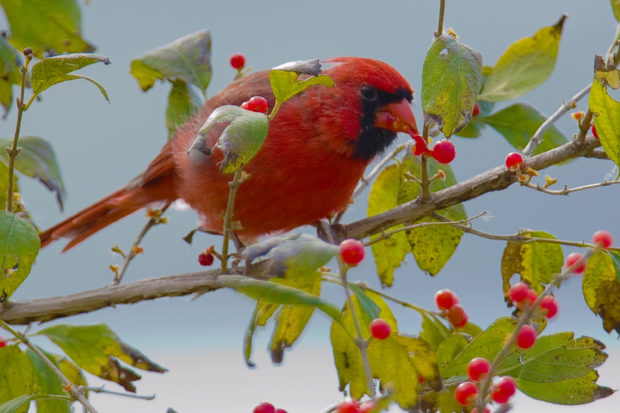We have much more to do and your continued support is needed now more than ever.
Winter Berries for Birds

Food is one of the four essential elements for wildlife habitat, and berry-producing shrubs are one of the best food sources for birds, particularly in the winter when other food sources are scarce.
Common bird species that do not migrate, such as northern cardinals, woodpeckers and mockingbirds, depend on berrying shrubs in winter. In addition to providing winter food, berrying shrubs are multi-functional. Shrubs planted densely in a border attract many more birds to your property like cardinals and thrushes seeking cover and nesting places. In the spring, flowers are a nectar source for pollinators.
Ornamental Benefits of Berries
It’s not just the birds and other wildlife that benefit from berrying shrubs. As a bonus, they also provide year-round benefits for your landscape in color, form and function.
Planting a selection of deciduous, semi-evergreen and evergreen creates a color palette bridging each season. In order to produce berries, deciduous shrubs must flower each spring to soften the garden with white or pastel shades contrasted by the bright green of new growth. Many of these shrubs continue to flower through the summer.

Come fall, shrubs like the choke cherry, staghorn sumac and native viburnums‘ leaves turn to warm yellows and reds. In the winter, these shrubs add needed color to a barren landscape. In the east, the purple, beaded berries of the American beautyberry and out west, the white snowberry, offer a contrast to the browns and evergreens found in winter. Adding a pop of holiday color, the versatile winterberry holly, native to the eastern half of the United States, has bright red sprays of berries to ornament your yard.
Long after your native flowering perennials have disappeared, semi-evergreen and evergreen shrubs like bayberry and juniper provide texture and form to your landscape. Grown as a border they offer screening from wind and enhance privacy.
What do the Birds Say?
Your habitat can come alive with sounds of animated birds feeding in a yard full of winter-persistent berries. Songbirds migrating in late fall may stop on your property attracted to the high fat content of the red-osier dogwood to fuel their journey. The shrub of this fruit also attracts robins, bluebirds, thrushes, catbirds, vireos, kingbirds, juncos, cardinals, warblers, wild turkey and grouse. Cedar waxwings, wintering tree swallows, bluebirds and catbirds like the food produced by a combination of deciduous, semi evergreen and evergreen shrubs that bear small fruits such as eastern redcedar, Rocky Mountain juniper, northern bayberry and southern waxmyrtle. Deciduous shrubs that also attract a wide variety of many bird species include nannyberry and arrowood viburnums, staghorn sumac, winterberry holly, red and black choke cherry, American Washington hawthorn, and inkberry.

Many of the shrubs listed above are native to large areas of the U.S. Others such as Douglas hawthorn and snowberry are native to the Pacific Northwest, while the inkberry is a coastal mid-Atlantic shrub.
To promote habitat biodiversity, the National Wildlife Federation encourages the planting of shrubs native to your ecoregion, as they will be more adaptive and provide a source of food appropriate for birds and other wildlife species native to your region. Visit our Native Plant Finder to find native plants in your zip code ranked by the number of butterflies and moths that use them as caterpillar host plants.
Enjoy the birds and berries this winter!
Help backyard birds and other native wildlife all year long by becoming a wildlife gardener!





















